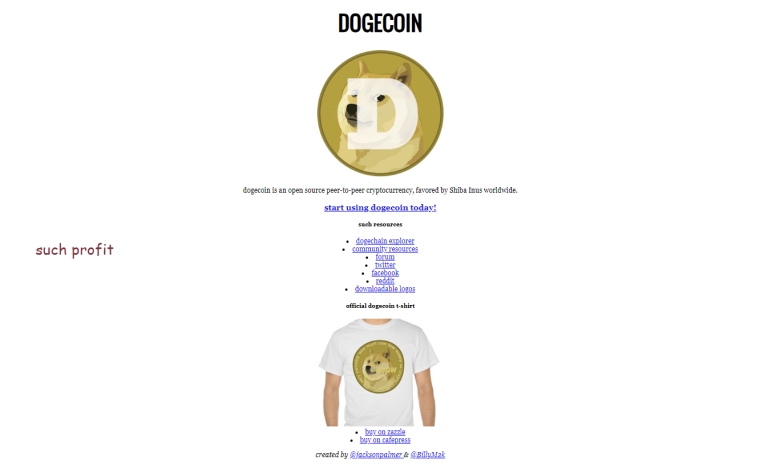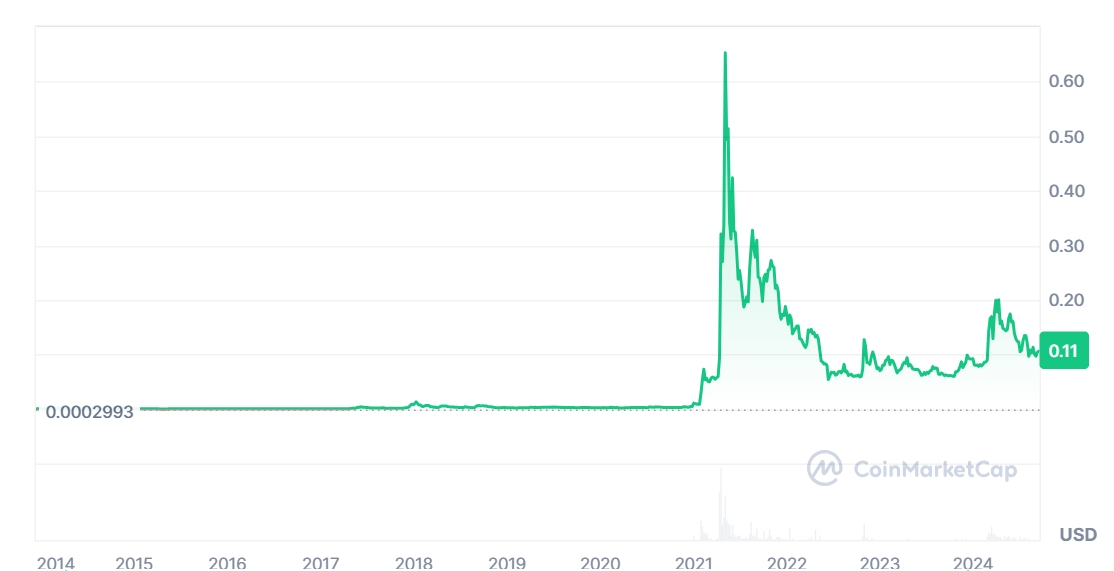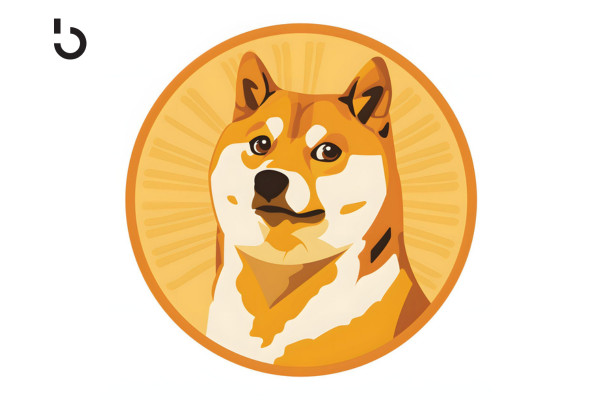Should You Invest in Dogecoin (DOGE)? Charts, Stats, Analysis for 2024
 bitcoinmarketjournal.com 15 September 2024 23:22, UTC
bitcoinmarketjournal.com 15 September 2024 23:22, UTC At Bitcoin Market Journal, we invest in crypto tokens as if they were stocks. While there are important differences between the two, we analyze crypto “companies” like traditional companies, and diversify our investments with a mix of both.
Key Takeaways:
- Because of its origins as the OG memecoin, Dogecoin has remained one of the top cryptocurrencies by market cap. It has spawned literally thousands of imitators, with very few of these memecoins having any intrinsic value.
- But investors must ask: what is the intrinsic value of Dogecoin? We believe there is very little, especially compared to more technically robust crypto projects that are building meaningful companies and products on blockchain.
- Dogecoin also has an unlimited token supply and a high emission rate, which makes it an inflationary asset, which is less attractive as a long-term investment.
The story of Dogecoin begins in 2013, with three key players: Jackson Palmer, a software engineer and marketing analyst; Billy Markus, a software developer; and a Shiba Inu.
(Actually, it was just a picture of a Shiba Inu that had gone viral as the doge meme.)
During the first crypto boom, Jackson Palmer created Dogecoin as a satirical commentary on the hype surrounding cryptocurrencies. He joked on Twitter about investing in a new “Dogecoin,” based on the meme, and the response was so positive that Palmer purchased the domain dogecoin.com.

Meanwhile, across the globe, Billy Markus was working as a software developer at IBM and had been contemplating the creation of a new digital currency. He stumbled upon the newly created dogecoin.com, and reached out to Palmer, expressing his interest in collaborating. And thus, DOGE was born.

Within 30 days of launch, over a million visitors accessed Dogecoin.com, and in January 2024 the trading volume of DOGE briefly surpassed bitcoin and all other cryptocurrencies combined.
By 2015, the hype around Dogecoin had cooled, and the project maintained a low profile through the end of the decade. In 2021, everything changed.

The year began with a renewed surge of interest in cryptocurrencies, and Dogecoin found itself at the center of this whirlwind. Elon Musk’s playful endorsements, referring to Dogecoin as his favorite cryptocurrency, sent its value skyrocketing, even breaking into the top 5 cryptocurrencies by market capitalization.
Its value has fallen since then, but the token remains one of the top cryptocurrencies. The team has since tried to build out the project as a payment and tipping currency, not just another memecoin.
Key Fundamental Data
Daily Active Users (DAU): According to IntoTheBlock, Dogecoin records over 43k daily active users. Its DAU has seen spikes over the past year but has mostly hovered around the 40k range without significant growth or decline.
Fees and Revenues: Dogecoin generates revenue primarily through transaction fees, paid by users to miners for processing and validating transactions on the network. However, Dogecoin’s high emission schedule of 10,000 DOGE per block per minute suggests that transaction fees alone might not be enough to sustain miner incentives long-term.
Market Cap: The market cap of Dogecoin has increased from approximately $10 billion to $18 billion over the past year, representing an 80% increase. Compared to other memecoins, Dogecoin’s market cap remains significantly higher, nearly double that of its closest competitor, Shiba Inu, which has a market cap of around $9.8 billion.
Market Analysis
Problem that it solves: Dogecoin addresses the need for a fun, engaging, and low-cost cryptocurrency for microtransactions and tipping online. However its value is driven more by its community and popular culture, rather than underlying technological innovation.
Customers: Most people who buy Dogecoin are Internet users, social media communities, and cryptocurrency enthusiasts who are in on the joke.
Value creation: Dogecoin markets itself as a practical currency, because it processes transactions more quickly and cheaply than cryptocurrencies like bitcoin. However, the number of merchants that accept Dogecoin is very small.
Market structure: Thousands of memecoins have been created, though Dogecoin is by far the biggest and best known.
Market size: Dogecoin’s potential market size is difficult to predict, as it has largely surpassed expectations of being just a memecoin. Daily trading volume alone in the coin has averaged nearly $1.4 billion in 2024. There’s a possibility that it will continue to grow along with the general crypto trend.
Regulatory risks: All crypto assets bear some regulatory risk; as the largest memecoin, Dogecoin has more risk in this category.
Our analysts rated DOGE a 2.8 out of 5 for market analysis. Download the complete scorecard here.
Competitive Advantage
How big is the company moat? Can they defend against competitors?
Technology/blockchain platform: Dogecoin runs on its own proof of work blockchain.
Lead time advantage: DOGE was the first memecoin, and has certainly benefited from being a first mover in the space.
Contacts and networks: Dogecoin has shown a well-developed network, at one point even having members like Vitalik Buterin on its advisory board.
Our analysts rated DOGE a 3.5 out of 5 for competitive advantage. Download the complete scorecard here.
Management Team
Does the team have the experience, intelligence, and integrity to make the company great?
Entrepreneurial team: Dogecoin was created by a pair of software engineers with limited blockchain experience but has built a solid team over the years.
Industry/technical experience: The creators of Dogecoin were newcomers to the industry, but now the team includes experienced developers who have been maintaining the project for over a decade.
Integrity: One of Dogecoin’s biggest controversies surrounds Elon Musk, the billionaire CEO of Tesla and Twitter, who was accused of using DOGE for insider trading by investors in a lawsuit.
Our analysts rated DOGE a 2.5 out of 5 for the management team. Download the complete scorecard here.
Token Mechanics
Is the token design favorable to long-term investors?
Is a token necessary? DOGE is the project’s product, mostly used as a payment and tipping currency for positive impact.
Value added: DOGE is the first of its kind. While it was created literally as a nonsensical clone of bitcoin, the messaging has since pivoted to “the accidental crypto-movement that makes people smile.”
Decentralized: Dogecoin is decentralized, though it does have a core team, who have laid out a development plan called the Trailmap.
Token supply: The total supply of DOGE is uncapped, with 145 billion tokens already in circulation. As more tokens are minted, the pie gets bigger, and your share of the pie gets smaller.
Public exchange: DOGE is listed on popular exchanges like Binance, Coinbase, and Kraken.
MVP: Dogecoin was launched in late 2013.
Our analysts rated DOGE a 3 out of 5 for token mechanics. Download the complete scorecard here.
User Adoption
How easy will it be for the company to grow users?
Technical Difficulty: Dogecoin is meant to be a fun and lighthearted version of crypto, which may be appealing to some people. However, it still suffers from the usual crypto complexity.
Halo Effect: Dogecoin has partnered with retailers and companies such as Tesla, SpaceX, and the Dallas Mavericks, to name a few.
Buzz: Dogecoin puts up impressive numbers when it comes to social media: its Twitter account alone has over 3.9 million followers. Its subreddit is even more impressive with over 2.5 million members.
Our analysts rated DOGE a 4 out of 5 for buzz. Download the complete scorecard here.
Potential Risks
What risk factors might cause intelligent investors to stay away?
Team: Dogecoin initially started as a joke without long-term plans.
Financial: Dogecoin has a development fund holding over $1.4 million in assets. However, this fund is held 100% in DOGE, which is risky. Additionally, the coin’s unlimited supply may impact its long-term value.
Regulatory: There is potential scrutiny from regulators due to Dogecoin’s viral nature and high-profile endorsements.
Smart Contract: Dogecoin does not have smart contract functionality, as it is primarily a currency.
Traction: Dogecoin has no problem attracting users, but its traction is still heavily dependent on social media buzz and endorsements.
Behavioral: The project started as a joke and that is still its primary perception, even though the current team is trying to change the coin’s narrative to having real value. So, it is likely that some are investing in DOGE out of greed rather than the project’s future potential.
Our analysts rated DOGE a 3 out of 5 for risk (Note that for this section lower = better). Download the complete risk scorecard here.
Investor Takeaway
BULL CASE: Dogecoin’s playful nature and meme origin have created a loyal following, making it one of the most recognized cryptocurrencies globally. The token benefits from high-profile endorsements from celebrities like Elon Musk, who propel it into mainstream consciousness. Additionally, as the original memecoin, Dogecoin also enjoys the advantages of being a pioneer in this unique niche. Its early entry into the market has allowed it to build a significant lead over competitors like Shiba Inu.
BEAR CASE: Dogecoin’s high emission rate of 10,000 DOGE per block and its infinite supply of tokens can lead to inflation and reduced value over time, making it less attractive as a long-term investment. Also, as a memecoin, the price and popularity of Dogecoin are heavily influenced by social media and celebrity endorsements. This creates volatility and makes it susceptible to sudden price swings based on public sentiment rather than intrinsic value.
Overall, our analysts rated DOGE a 3.2 out of 5, based on its strengths in popularity and community engagement, balanced against risks related to intrinsic value concerns. Download the complete scorecard here.
This analysis is to help make you a better-informed investor; it is not financial advice. The future may look different than the past. All investing involves risk; see our investing approach for how we manage risk through diversification. Never invest more than you’re willing to lose, and see losses as learning.




